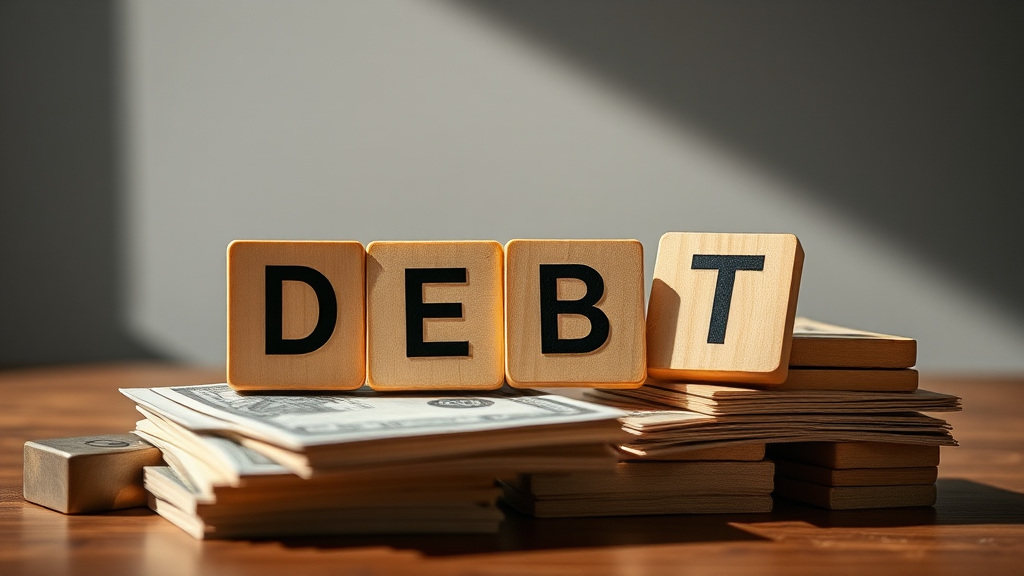Common Types of Debt
Credit, Medical, Student, Payday
debt, types
Credit Card Debt involves high-interest rates and can hurt your credit score. Managing strategies include paying more than the minimum balance and consolidating debt.
Medical Debt can be a burden, mitigated by health insurance. Negotiating bills and managing payments are key strategies.
Student Debt is common, with federal and private loans offering different terms. Repayment plans can make it manageable.
Payday Loan Debt is risky due to high interest. Consider alternatives and repayment methods.
Tax Debt has serious consequences. Setting up payment plans with the CRA and proactive management can help.

Article: Common Types of Debt
Credit Card Debt
High-interest rates and revolving balances., Impact on credit score if not managed well., Common strategies for managing and paying off credit card debt.
High-interest rates on credit cards in Canada can quickly turn a manageable balance into an overwhelming debt. With rates often hovering between 19% to 29%, the cost of carrying a revolving balance can escalate, especially if you're only making the minimum payment. For instance, if you have a balance of $5,000 at an interest rate of 20%, and you only pay the minimum each month, it could take you years to pay off the debt, costing you thousands in interest alone. This is a trap many Canadians fall into, making it essential to have a strategy in place to handle credit card debt efficiently.
Mismanaging credit card debt can have a severe impact on your credit score, which is crucial for your financial health. A high balance relative to your credit limit, frequent late payments, or defaulting on the debt can significantly drop your score. This makes it harder to obtain loans, mortgages, or even rental agreements in the future. Imagine the stress of wanting to buy a home and discovering that your credit score is too low to qualify for a favorable mortgage rate. Preventing this scenario involves paying more than the minimum amount, paying on time, and trying to keep your credit utilization ratio below 30%.
Several common strategies can effectively manage and pay off credit card debt. One popular method is the debt avalanche approach, where you tackle debts with the highest interest rates first to minimize the total interest paid over time. Another strategy is the debt snowball method, which involves paying off the smallest debts first to build momentum and achieve quick wins. Additionally, consider transferring your balance to a lower interest credit card or consolidating your debts with a personal loan. Each strategy has its pros and cons, so it’s essential to choose one that aligns with your financial situation and personal habits. For example, if you thrive on seeing quick progress, the snowball method might be the best fit for you.
Medical Debt
Unexpected medical expenses and their financial burden., Importance of health insurance in mitigating medical debt., Options for negotiating medical bills and managing payments.
Unexpected medical expenses can catch anyone off guard, creating a significant financial burden. Imagine you’ve just had an emergency surgery, and while the bulk of the costs are covered by Canada’s healthcare system, you’re left with unexpected bills for things like prescription medications or specialized equipment not fully insured. These out-of-pocket expenses can quickly add up, leaving many Canadians scrambling to find ways to pay them off without derailing their financial stability.
The importance of health insurance cannot be overstated when it comes to mitigating medical debt. While Canada’s public healthcare system is robust, it doesn’t cover everything. Private health insurance fills in the gaps, helping with costs related to dental care, vision, prescription drugs, and other services. For instance, if you were recently diagnosed with a chronic condition requiring ongoing treatment and medications, having additional health coverage can significantly reduce your out-of-pocket expenses, safeguarding your savings.
If you find yourself struggling with medical bills, there are options to negotiate and manage these payments effectively. Start by speaking directly with your healthcare provider or hospital; many are open to setting up payment plans or reducing the total amount owed if you explain your financial situation. Additionally, non-profit credit counseling services can offer advice and assistance in dealing with medical debt. For example, if you owe $4,000 in medical bills, you might be able to negotiate a payment plan that allows you to pay $200 monthly over a specified period, making the debt more manageable.
Elimiate up to 80% of Your Debt
High cost of gas, high cost of groceries, high lending rates, low salary - being in debt is not your fault! See if you qualify for government debt programs and get out of debt today!
Student Debt
Prevalence of student loans among Canadian graduates., Differences between federal and private student loans., Repayment plans and strategies for reducing student debt.
Navigating student loans is a common experience for many Canadian graduates. About half of all Canadian students graduate with some form of student debt, with the average amount hovering around $28,000. This debt burden can feel overwhelming, but understanding the differences between federal and private student loans can help manage it more effectively. Federal student loans, such as those provided through the Canada Student Loans Program, are typically more flexible and come with lower interest rates. They also offer benefits like repayment assistance and potential loan forgiveness. On the other hand, private student loans, offered by banks and other financial institutions, tend to have higher interest rates and less lenient repayment terms.
Let’s break it down a bit more. Federal student loans are supported by the government, meaning they often have fixed interest rates and various repayment options that can be tailored to your income. These loans also offer grace periods—typically six months—after graduation before you need to start repayments. Private loans, however, can carry variable interest rates and stricter repayment schedules, making them a riskier option if your financial situation changes. For instance, if you lose your job after graduation, managing a private loan can be much more challenging compared to a federal one.
When it comes to repayment plans and strategies for reducing student debt, there are several paths you can take. Income-driven repayment plans are popular, as they adjust your monthly payments based on your income, ensuring affordability. Additionally, making extra payments whenever possible, such as putting any tax refunds or work bonuses directly toward your debt, can reduce the principal balance faster. Another effective strategy is consolidating federal loans into one monthly payment, which can simplify your finances and potentially lower your interest rate. Remember, staying proactive and informed about your repayment options is the key to tackling student debt efficiently.

Explore the common types of debt you might encounter.
Payday Loan Debt
Short-term high-interest loans and their risk., Regulations regarding payday loans in Canada., Alternatives to payday loans and methods for repayment.
Payday loans in Canada are short-term, high-interest loans designed to provide quick cash to those in need. However, these loans often come with exorbitant interest rates and fees—sometimes as high as 500% annually—which can quickly turn a small loan into significant debt. Imagine needing $500 for an emergency but finding yourself owing more than $1,000 within just a few months. The cycle of borrowing and repayments can become a relentless treadmill, worsening your financial situation rather than helping.
Fortunately, there are regulations in Canada that aim to protect consumers from falling too deeply into the payday loan trap. Each province has its own set of rules, such as caps on interest rates and the total cost of borrowing. For instance, in Ontario, the maximum cost of borrowing is $15 for every $100 borrowed. Additionally, payday lenders are required to be transparent about their fees and provide clear, comprehensive contracts. These measures are designed to promote fair lending practices, though they may not be foolproof against deeper financial woes.
Alternatives to payday loans can be far more beneficial in managing financial hardships. Credit counseling services offer debt management plans that lower interest rates and consolidate multiple debts into one affordable payment. Other options include borrowing from a credit union, which often offers lower rates and more flexible terms, or using a credit card with a lower interest rate. Once the immediate debt is under control, establishing a repayment strategy is crucial. For example, the avalanche method—paying off the highest interest rate debt first—can save on total interest paid over time. Taking these steps can lead to long-term financial stability and freedom from the payday loan cycle.
Tax Debt
Consequences of not paying tax debts on time., Options for setting up payment plans with the CRA., Strategies for dealing with large tax debts and avoiding future issues.
Failing to pay your tax debts on time in Canada can have some serious consequences. The Canada Revenue Agency (CRA) can impose penalties and interest on the outstanding amount, which can quickly add up, making the debt much larger than the original amount owed. Beyond financial penalties, the CRA has robust powers to collect on tax debts, including garnishing your wages or bank accounts, seizing and selling your assets, and even placing a lien on your property. To avoid these harsh outcomes, it’s crucial to address your tax debt as soon as possible.
If you can’t pay your tax debt in full, setting up a payment plan with the CRA is a viable option. The CRA offers various installment payment arrangements tailored to individual circumstances. For instance, they allow you to pay off your debt in manageable monthly installments. To get started, you’ll need to provide a detailed financial statement, including your income, expenses, assets, and liabilities. This helps the CRA assess your situation and agree on a payment plan that won’t leave you strapped for cash. Be honest and realistic about what you can afford to ensure the plan is sustainable.
Dealing with large tax debts requires strategic planning to avoid falling into the same trap again. One effective strategy is to seek professional help from a tax advisor or a debt relief expert specializing in tax issues. They can help negotiate with the CRA on your behalf and potentially reduce the amount you owe through various relief programs. Additionally, to avoid future tax debt, consider setting aside funds regularly for your tax obligations, especially if you are self-employed or have an irregular income. Using tax software or consulting with an expert to ensure you claim all eligible deductions and credits can also help minimize your tax liability.
References
| Title, Source |
|---|
| Managing Credit Card Debt in Canada, Government of Canada |
| Health Costs and Financial Implications, Canadian Medical Association |
| Student Debt in Canada, Statistics Canada |
| Payday Loans – Protect Yourself, Consumer Protection Ontario |
| Tax Debt Payment Plan, Canada Revenue Agency (CRA) |
This article references information from the above sources.
Eliminate up to 80% of Your Debt
High cost of gas, high cost of groceries, high lending rates, low salary - being in debt is not your fault! See if you qualify for government debt programs and get out of debt today!